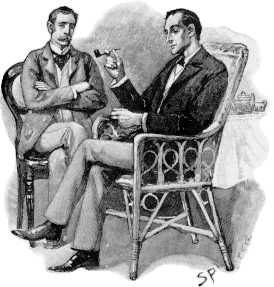A Treatise on the Binomial Theorem
A Treatise on the Binomial Theorem is a fictional work of mathematics by the young Professor James Moriarty, the criminal mastermind and archenemy of the detective Sherlock Holmes in the fiction of Arthur Conan Doyle. The actual title of the treatise is never given in the stories; Holmes simply refers to "a treatise upon the binomial theorem." The treatise is mentioned in the short story "The Final Problem", when Holmes, speaking of Professor Moriarty, states:
He is a man of good birth and excellent education, endowed by nature with a phenomenal mathematical faculty. At the age of twenty-one, he wrote a treatise upon the binomial theorem, which has had a European vogue. On the strength of it he won the mathematical chair at one of our smaller universities, and had, to all appearances, a most brilliant career before him.— Sherlock Holmes, The Final Problem
Moriarty was a versatile mathematician as well as a criminal mastermind. In addition to the Treatise, he wrote the book The Dynamics of an Asteroid, containing mathematics so esoteric that no one could even review it. This is a very different branch of mathematics from the Binomial Theorem, again showing his impressive intellectual prowess.
The "smaller university" involved has been claimed to be one of the colleges that later comprised the University of Leeds.[1] However, in Sherlock Holmes: The Unauthorized Biography, the "smaller university" is said to be Durham.[2]
Review and discussion
Doyle, in his works, never describes the contents of the treatise. This has not stopped people from speculating on what it might have contained. Davis, in the book The Summation of Series, attributes certain binomial identities to Moriarty.[3] These have been expanded on in further work,[4] firmly tying Treatise into the standard mathematical literature. Less formal depictions of the content are also available. For example, science fiction writer Poul Anderson wrote about the treatise for the Baker Street Journal.[5]
Treatise is sometimes used when a reference is needed to a non-specific example of a scientific paper.[6]
Other references
In The Seven-Per-Cent Solution, a Holmes pastiche by Nicholas Meyer, Moriarty in conversation with Watson denies any treatise on the binomial theorem, saying: "Certainly not. Who has anything new to say about the binomial theorem at this late date? At any rate, I am certainly not the man to know." In this novel, Moriarty is no evil genius, but simply a harmless math teacher who became a monster in Holmes' fantasies because he was involved in certain traumatic childhood experiences of his.
See also
- The Dynamics of an Asteroid, another fictional work by Moriarty
- List of fictional books invented by Sir Arthur Conan Doyle
References
- ↑ Bowers, John F., "James Moriarty: A Forgotten Mathematician", December 23, 1989, New Scientist
- ↑ Nick Rennison, Sherlock Holmes: The Unauthorized Biography, p. 68
- ↑ Davis, Harold T. (1962). The summation of series. Principia Press of Trinity Univ., p 71.
- ↑ H. W. Gould (October 1972). "The case of the strange binomial identities of Professor Moriarty". Fibonacci Quarterly 10 (4): 381–392,402.
- ↑ Anderson, Poul. A Treatise on the Binomial Theorem, Baker Street Journal, 5, No. 1 (January 1955), 13-18.
- ↑ This is the case in an example review of a computer science paper (in PDF format).
External links
- A list of many references to this work, as well as to other works of Moriarty's such as The Dynamics of an Asteroid.
| ||||||||||||||||||||||||||||||||||||||||||
